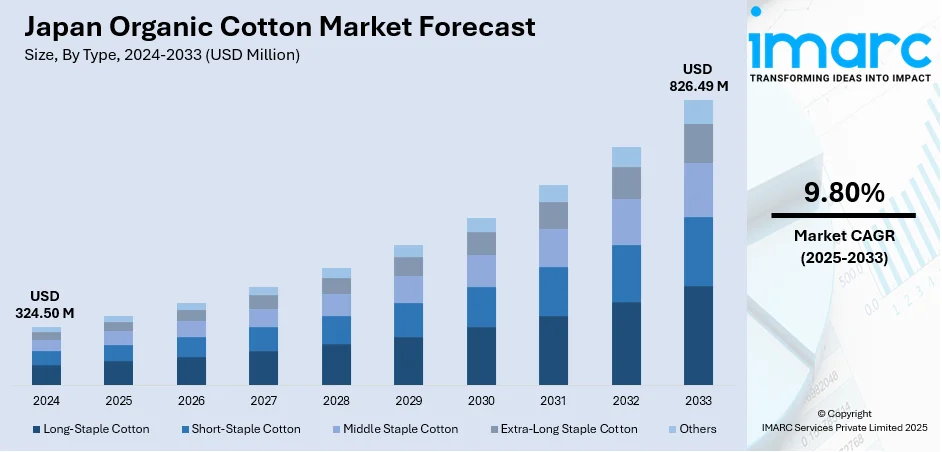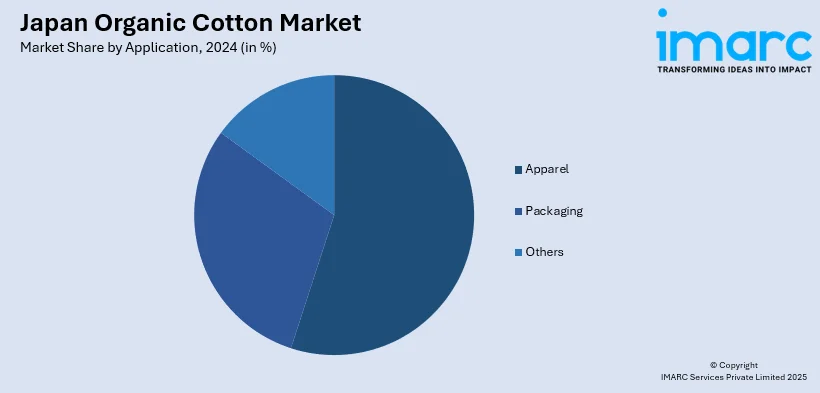
Japan Organic Cotton Market Size, Share, Trends and Forecast by Type, Quality Type, Application, and Region, 2025-2033
Japan Organic Cotton Market Overview:
The Japan organic cotton market size reached USD 324.50 Million in 2024. Looking forward, IMARC Group expects the market to reach USD 826.49 Million by 2033, exhibiting a growth rate (CAGR) of 9.80% during 2025-2033. At present, people are favoring products that feature explicit certifications and transparent supply chains, as they guarantee the product’s genuineness and environmental friendliness. This is driving the demand for organic cotton. Besides this, the increasing uptake of e-commerce platforms, which allows individuals to conveniently compare prices and review product ratings, is contributing to the expansion of the Japan organic cotton market share.
|
Report Attribute
|
Key Statistics
|
|---|---|
|
Base Year
|
2024
|
|
Forecast Years
|
2025-2033
|
|
Historical Years
|
2019-2024
|
| Market Size in 2024 | USD 324.50 Million |
| Market Forecast in 2033 | USD 826.49 Million |
| Market Growth Rate 2025-2033 | 9.80% |
Japan Organic Cotton Market Trends:
Increasing consciousness about environmental sustainability
Rising consciousness about environmental sustainability is positively influencing the market in Japan. People are understanding the environmental impact of conventional cotton farming, including pesticide use, water intake, and soil degradation. This awareness is encouraging people to choose organic cotton products that are grown without harmful chemicals and employ sustainable farming practices. Japanese shoppers continue to seek eco-friendly options in clothing, bedding, and baby products to support a healthier planet. Media campaigns, environmental organizations, and brands are promoting the benefits of organic cotton, helping educate individuals on its positive effects. Many Japanese customers prefer products with clear certifications and transparent supply chains, which assure them of the product’s authenticity and eco-friendliness. Trends like minimalism are also driving the demand for organic cotton, as people want to minimize waste and support sustainable lifestyles. Additionally, rising disposable incomes allow more people to afford premium-priced organic cotton products, further stimulating the market growth. The combination of the growing environmental concerns and improved purchasing power leads to the steady expansion of the market. As sustainability is becoming a key factor in buying decisions, organic cotton is gaining popularity and driving innovations in the textile industry. Moreover, increasing textile exports are offering a favorable market outlook. As per the OEC, in 2024, Japan's exports of textiles reached ¥1.01T, making it the 11th most exported item (out of 22) from Japan.

To get more information on this market, Request Sample
Expansion of e-commerce portals
The broadening of e-commerce sites is fueling the Japan organic cotton market growth. As per the IMARC Group, the Japan e-commerce market size reached USD 258.0 Billion in 2024. Online platforms offer a wide range of organic cotton products, including clothing, bedding, baby care items, and personal care textiles, all available with just a few clicks. E-commerce enables people to easily compare prices, read product reviews, and explore brand values related to sustainability and ethical sourcing. Many niche and eco-conscious brands are using online channels to reach a broader audience, especially younger urban shoppers who prefer digital shopping. Detailed product descriptions, eco-certifications, and transparent supply chain information build trust and encourage purchases. Subscription models and exclusive online collections are driving the demand for organic cotton goods. Social media integration and targeted advertising help drive traffic to online stores, where sustainability-conscious users are actively seeking organic options. With fast delivery and simple return policies, e-commerce removes barriers and makes organic cotton items more appealing and available nationwide. As digital retail continues to grow, it plays a vital role in supporting the expansion of the market in Japan.
Japan Organic Cotton Market Segmentation:
IMARC Group provides an analysis of the key trends in each segment of the market, along with forecasts at the country and regional levels for 2025-2033. Our report has categorized the market based on type, quality type, and application.
Type Insights:
- Long-Staple Cotton
- Short-Staple Cotton
- Middle Staple Cotton
- Extra-Long Staple Cotton
- Others
The report has provided a detailed breakup and analysis of the market based on the type. This includes long-staple cotton, short-staple cotton, middle staple cotton, extra-long staple cotton, and others.
Quality Type Insights:
- Supima/Pima
- Upland
- Giza
- Others
A detailed breakup and analysis of the market based on the quality type have also been provided in the report. This includes supima/pima, upland, giza, and others.
Application Insights:

- Apparel
- Packaging
- Others
The report has provided a detailed breakup and analysis of the market based on the application. This includes apparel, packaging, and others.
Regional Insights:
- Kanto Region
- Kansai/Kinki Region
- Central/ Chubu Region
- Kyushu-Okinawa Region
- Tohoku Region
- Chugoku Region
- Hokkaido Region
- Shikoku Region
The report has also provided a comprehensive analysis of all the major regional markets, which include Kanto Region, Kansai/Kinki Region, Central/Chubu Region, Kyushu-Okinawa Region, Tohoku Region, Chugoku Region, Hokkaido Region, and Shikoku Region.
Competitive Landscape:
The market research report has also provided a comprehensive analysis of the competitive landscape. Competitive analysis such as market structure, key player positioning, top winning strategies, competitive dashboard, and company evaluation quadrant has been covered in the report. Also, detailed profiles of all major companies have been provided.
Japan Organic Cotton Market News:
- In March 2025, the Vans Artist Collection event was announced in Japan, in which artists were to be invited from Asia to express their creative concepts via Vans products. The upcoming collaborator in the Vans Artists' Collection was Yusuke Hanai, a globally acclaimed artist from Japan. In its new edition, ‘Musee de la Vie’, a distinctive blend of Japanese aesthetic influences and American vintage vibes was to be highlighted. A key aspect was the utilization of eco-friendly materials, including renewable canvas fabrics, organic cotton, and recycled polyester, wherever feasible.
Japan Organic Cotton Market Report Coverage:
| Report Features | Details |
|---|---|
| Base Year of the Analysis | 2024 |
| Historical Period | 2019-2024 |
| Forecast Period | 2025-2033 |
| Units | Million USD |
| Scope of the Report |
Exploration of Historical Trends and Market Outlook, Industry Catalysts and Challenges, Segment-Wise Historical and Future Market Assessment:
|
| Types Covered | Long-Staple Cotton, Short-Staple Cotton, Middle Staple Cotton, Extra-Long Staple Cotton, Others |
| Quality Types Covered | Supima/Pima, Upland, Giza, Others |
| Applications Covered | Apparel, Packaging, Others |
| Regions Covered | Kanto Region, Kansai/Kinki Region, Central/Chubu Region, Kyushu-Okinawa Region, Tohoku Region, Chugoku Region, Hokkaido Region, Shikoku Region |
| Customization Scope | 10% Free Customization |
| Post-Sale Analyst Support | 10-12 Weeks |
| Delivery Format | PDF and Excel through Email (We can also provide the editable version of the report in PPT/Word format on special request) |
Key Questions Answered in This Report:
- How has the Japan organic cotton market performed so far and how will it perform in the coming years?
- What is the breakup of the Japan organic cotton market on the basis of type?
- What is the breakup of the Japan organic cotton market on the basis of quality type?
- What is the breakup of the Japan organic cotton market on the basis of application?
- What is the breakup of the Japan organic cotton market on the basis of region?
- What are the various stages in the value chain of the Japan organic cotton market?
- What are the key driving factors and challenges in the Japan organic cotton market?
- What is the structure of the Japan organic cotton market and who are the key players?
- What is the degree of competition in the Japan organic cotton market?
Key Benefits for Stakeholders:
- IMARC’s industry report offers a comprehensive quantitative analysis of various market segments, historical and current market trends, market forecasts, and dynamics of the Japan organic cotton market from 2019-2033.
- The research report provides the latest information on the market drivers, challenges, and opportunities in the Japan organic cotton market.
- Porter's five forces analysis assist stakeholders in assessing the impact of new entrants, competitive rivalry, supplier power, buyer power, and the threat of substitution. It helps stakeholders to analyze the level of competition within the Japan organic cotton industry and its attractiveness.
- Competitive landscape allows stakeholders to understand their competitive environment and provides an insight into the current positions of key players in the market.
Need more help?
- Speak to our experienced analysts for insights on the current market scenarios.
- Include additional segments and countries to customize the report as per your requirement.
- Gain an unparalleled competitive advantage in your domain by understanding how to utilize the report and positively impacting your operations and revenue.
- For further assistance, please connect with our analysts.
 Request Customization
Request Customization
 Speak to an Analyst
Speak to an Analyst
 Request Brochure
Request Brochure
 Inquire Before Buying
Inquire Before Buying




.webp)




.webp)












